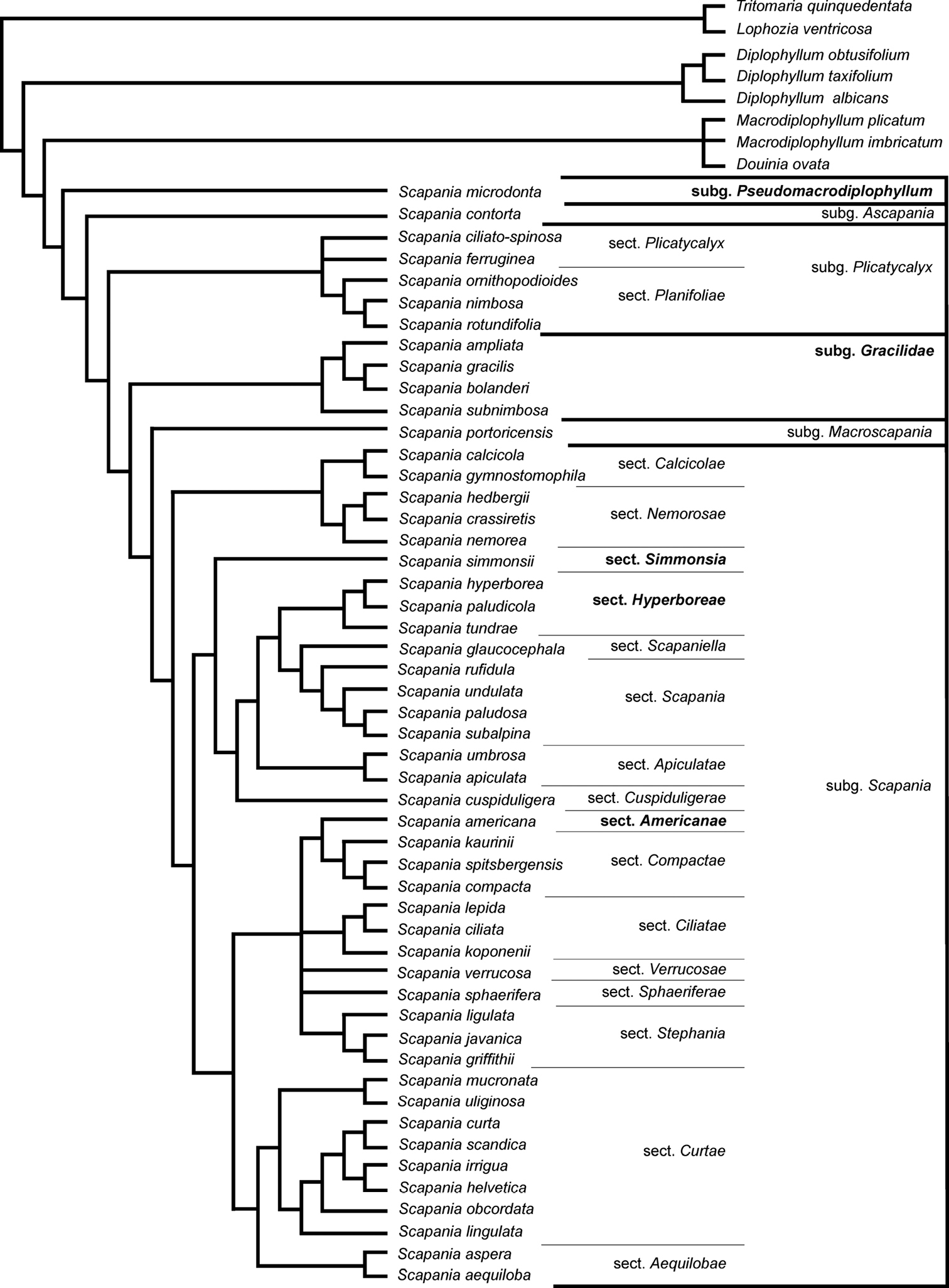






(C) 2012 Jiří Váňa. This is an open access article distributed under the terms of the Creative Commons Attribution License 3.0 (CC-BY), which permits unrestricted use, distribution, and reproduction in any medium, provided the original author and source are credited.
For reference, use of the paginated PDF or printed version of this article is recommended.
Five new supraspecific taxa of Scapania are proposed, Scapania subg. Gracilidae, Scapania subg. Pseudomacrodiplophyllum, Scapania sect. Americanae, Scapania sect. Hyperboreae, and Scapania sect. Simmonsia.
Scapaniaceae, nomenclature
The northern temperate leafy liverwort genus Scapania (Dumort.) Dumort. was the subject of two comprehensive molecular phylogenetic studies (
Phylogeny of Scapania with the new taxa indicated in bold. Modified from
Scapania sect. Gracilidae H. Buch, Commentat. Biol. 3(1): 106. 1928.
Scapania gracilis Lindb., Morgonbladet (Helsinki) 1873(286): 2. 1873.
According to the molecular phylogenies presented by
Scapania subg. Pseudomacrodiplophyllum includes species which differ from other Scapania elements by the presence of multicellular gemmae with intersecting walls, basal leaf cell walls with intermediate thickenings and pluriplicate perianths.
Scapania microdonta (Mitt.) Müll. Frib., Nova Acta Acad. Caes. Leop.-Carol. German. Nat. Cur. 83: 262. 1905.
Scapania microdonta [Macrodiplophyllum microdontum (Mitt.) Perss.] forms the sister clade to the rest of Scapania (
The new section of Scapania subg. Scapania is characterized by its type, the dioicous Scapania americana Müll. Frib. Distinctive features of Scapania americana and Scapania sect. Americanae are thick-walled, pigmented stem epidermis cells with thinner-walled cells on the ventral side of the stem, closely and sharply ciliate-dentate leaf-margins, with largest teeth up to five cells long and terminal cells considerably longer than wide, leaf-lobes that are usually decurrent beyond the level of the keel, a verruculose or striate-verruculose cuticle, and two-celled gemmae at the margins of unmodified leaves. The dorsal leaf-lobes often develop an undulate or folded base and may even show minute lobules or auricles.
Scapania americana Müll. Frib., Bull. Herb. Boissier, sér. 2, 3: 44. 1902.
Scapania americana is placed sister to Scapania sect. Compactae (Müll. Frib.) H. Buch with weak bootstrap support (
Species of Scapania sect. Hyperboreae resemble members of Scapania sect. Curtae (Müll. Frib.) H. Buch but differ by the presence of brownish to reddish gemmae, and a usually larger size.
Scapania hyperborea Jørg., Förh. Vidensk.-Selsk. Kristiania 1894(8): 56. 1894.
The presence of the type species of Scapania sect. Irriguae (Müll. Frib.) H. Buch, Scapania irrigua (Nees) Nees, in Scapania sect. Curtae necessitates the introduction of a new section for the remaining elements of Scapania sect. Irriguae. Molecular data so far supported the presence of Scapania paludicola Loeske & Müll. Frib. and Scapania tundrae (Arnell) H. Buch in S. subg. Scapania sect. Hyperboreae, as well as Scapania hyperborea (
Scapania subsect. Simmonsia [“Simmonsiae”] R.M. Schust., Hepat. Anthocerotae N. Amer. 3: 612. 1974.
Scapania simmonsii Bryhn & Kaal., Rep. Second Norweg. Arctic Exped. Fram 2 (11): 51. 1906.
Scapania simmonsii forms an isolated lineage within S. subg. Scapania, hence, we erect a section for this species rather than using subsectional rank (
We thank Prof. em. Dr. Gerhard Wagenitz (Göttingen), Dr. David Long and Dr. John McNeill (Edinburgh) for helpful discussions. Financial support of the Deutsche Forschungsgemeinschaft (grant HE 3584/4) is gratefully acknowledged.
